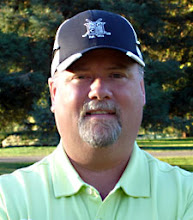Sunday, December 13, 2009
Frost on the Fairways
 When frost like this greets us in the early morning hours, we can forget about working on the course until 9:00 am or later. The frost varies throughout the course due to the wide variety of micro climates. On a very cool day, like the one pictured above, the entire playing surface is covered in a thick white blanket.
When frost like this greets us in the early morning hours, we can forget about working on the course until 9:00 am or later. The frost varies throughout the course due to the wide variety of micro climates. On a very cool day, like the one pictured above, the entire playing surface is covered in a thick white blanket.The first bit of frost will occur when our weather station registers 34 degrees or lower. The specific cause for frost is when surface temperatures drop below the dew point of the surrounding air. A light frost is common on a cool morning and many times will not interfere with our work. The staff is well trained to determine the severity of the conditions and make a judgement call of where they can drive, walk, and mow.
The first portion of turf to turn snowy white is the rough which has more air space within the canopy of leaves. The fairways are much tighter and they will require a deeper drop in temperatures before they are bitten by the frost. Finally, the greens will be frosted only when the mercury drops below freezing and settles in for a number of hours.
Once the sun rises, the frost actually gets worse as air temperatures continue to decline. This is when we can get a feel for the day and communicate with the proshop with such predictions as when can we set up the range, when is the first tee time, and will the putting green be open today. A portion of the putting green does not get any sunlight all winter long and sometimes will be roped off to protect it from foot traffic.
Now that we know we have frost, and have determined the severity and length of the delay, we now work backwards waiting for the greens to thaw last. The greens are always the last area to freeze and unfortunately are the final spots to open back up because of the tight turf and lack of air movement between the blades.

When a golfer, or in this instance, a staff member, jumps the gun and drives onto frozen turf, the result is brown streaks that can last all the way till spring. When foot or vehicular traffic meets frosted turf, the frozen cells within the plant are crushed. Sometimes only the leaf tip is damaged, but during a heavy frost, when the entire plant is basically frozen, the turf can be crushed from top to bottom including the crown. The crown is the growing point of a turf plant and lies just above the soil. If the crown is lost, so is the plant.

So if you get to the course a little early and see a blanket of white where there should be green, grab a cup of coffee and some breakfast and enjoy the view. A frost covered golf course is a winter wonderland, but certainly a 'look don't touch' situation.
Subscribe to:
Post Comments (Atom)


0 comments:
Post a Comment